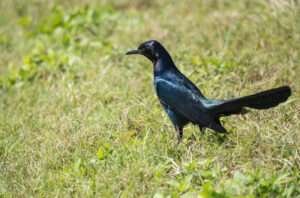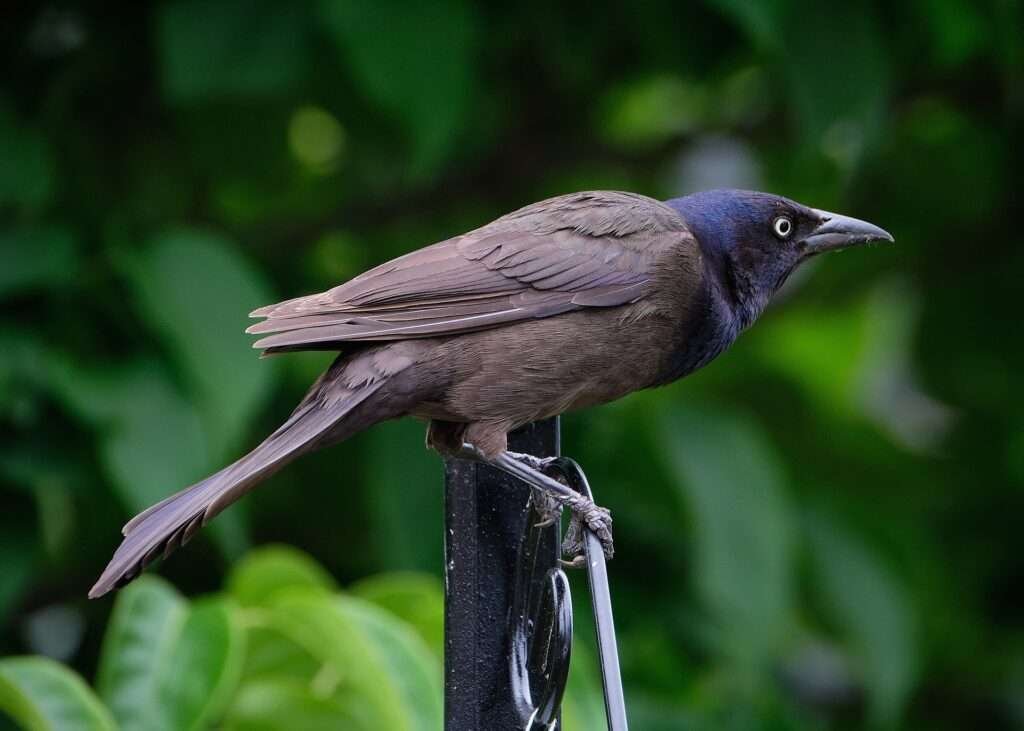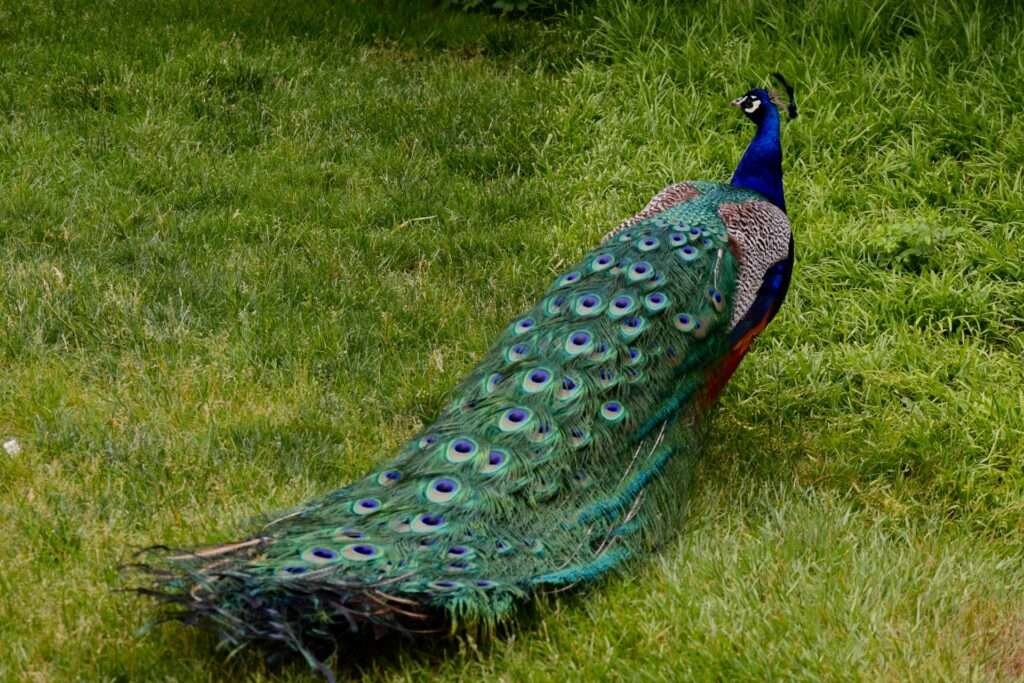The Common Grackle is a large blackbird found across North America. It is known for its iridescent body and distinctive yellow eye.
Encountering the Common Grackle is a common experience for those exploring parks and fields in North America. These birds exhibit a striking luminescence that can appear purple, blue, or green in the right light. With their loud and varied calls, grackles are hard to ignore in their preferred habitats, which range from woodlands to suburban areas.
Their adaptability to different environments, including agricultural and urban areas, contributes to their widespread presence. The Common Grackle’s diet is as diverse as its habitat, consisting of seeds, insects, small mammals and other birds, showcasing their opportunistic feeding behaviour. Their nesting practices are communal, often forming large, noisy colonies that dominate the treetops. Bird enthusiasts and casual observers alike can appreciate this resilient avian species’ distinct features and behaviours.
Identifying Them

The common Grackle is a striking bird, easily recognisable by its glossy iridescent plumage, which often appears black with hints of blue or purple in the light. This bird also sports a long, keel-shaped tail and a sharp beak, which are distinctive physical characteristics.
Male grackles are typically larger than females and boast a more vibrant sheen. People often observe these birds foraging on the ground in open areas, demonstrating their diverse diet of insects, seeds, and even small vertebrates. A keen observer will note the Grackle’s unique behaviour during the breeding season, where males display their tail feathers and emit various sounds to attract mates.
Their presence is familiar across North America, particularly in the eastern and central regions. They adapt well to rural farmlands and bustling urban environments.
What They Eat
The common Grackle’s diverse diet reflects its adaptability to different environments. These opportunistic foragers feast on various edibles, with their palate spanning insects such as beetles and grasshoppers to grains and seeds. Their dietary preferences shift throughout the seasons; when insects are abundant in spring and summer, they indulge in a protein-rich menu.
Come fall and winter, they switch to plant-based offerings, including acorns and crops. Notoriously known to raid bird feeders, grackles are fond of sunflower seeds and corn, often outwitting preventative measures with their intelligence and persistence. This flexibility in their diet is a key to their survival, allowing them to thrive in rural and urban settings.
Where They Nest and Their Eggs
Common grackles are known for their adaptability. They often build their nests in diverse locations, from isolated trees to bustling urban areas. These resourceful birds are not particular about their nesting sites, opting for spots like dense shrubbery or high branches to keep their brood safe from predators.
Their nests, primarily constructed by females, comprise twigs, grass, and mud, creating a sturdy foundation for their eggs. The eggs themselves are a sight to behold, with a smooth surface and a pale blue hue, speckled with brown and purple marks.
Each clutch typically contains 4–7 eggs, and during the breeding season, if a nest is discreetly observed from a distance, one might get a glimpse of these striking eggs. This clever nesting strategy enables common grackles to thrive across various environments, making them a familiar sight in many regions.
Their current status

With their iridescent plumage and distinct vocalisations, Grackles have carved a niche in various ecosystems across North America. While often spotted in large numbers, their ubiquity masks the nuanced shifts in their population dynamics. Environmental changes and habitat disruptions have begun to influence their numbers, prompting ornithologists to monitor these birds closely.
Understanding the ecological balance that common grackles maintain becomes increasingly important because it will shed light on broader environmental health indicators. These adaptable birds continue to thrive while sharing space with humans in urban expanses, but the future of their population is under scrutiny.
Observations and data collected over time will determine if protective measures are necessary to ensure their sustained presence in our natural tapestry.
Interesting Facts
The common Grackle is a bird that often goes unnoticed despite its unique attributes. With its shimmering iridescent plumage, typically boasting a mesmerising blue head and a bronze-tinged body, the common grackle is a sight to behold in the right light.
Known for their adaptability, these birds thrive in various environments across North America. While their vocalisations might not be musical, their keening calls are unmistakable. These birds exhibit intelligence, with some displaying remarkable problem-solving skills for avian species.
During the breeding season, the males’ vibrant eyes stand out, their golden hue contrasting against the darkness of their feathers, a detail that bird enthusiasts and casual observers alike find fascinating. They play a significant role in the ecosystem, helping control insect populations and acting as seed dispersers, yet they sometimes challenge farmers by feasting on crops.
Species That Look Alike
Distinctive yet often confused with other species, the Common Grackle is part of a more prominent family of birds that encompasses a variety of similar-looking feathered cohorts. Starlings and blackbirds frequently puzzle bird enthusiasts and casual observers with their glossy sheens and comparable body structures.
Expert birdwatchers suggest focusing on subtle differences, such as the tail’s shape and the iridescence pattern, to distinguish between these avian relatives. The Grackle’s longer, keel-shaped tail and striking purple-blue lustre set it apart from peers like the Red-winged Blackbird or the European Starling, which display different body lengths and wing colourations.
Frequently Asked Questions of Common Grackle
Are Grackles Good for Your Yard?
Grackles can be both beneficial and problematic for yards. They eat harmful insects and are suitable for gardens, but in large numbers, they may damage crops and be noisy.
Are common grackles aggressive?
Common grackles can be aggressive, especially when defending their nests during breeding season. They may also intimidate other birds at feeders.
Is a Grackle a Crow or a Raven?
A grackle is neither a crow nor a raven; it belongs to the Icteridae family, which differs from the Corvidae family, which includes crows and ravens.
Do grackles scare away other birds?
Grackles can scare away other birds due to their aggressive nature and tendency to dominate food sources.
Conclusion
Exploring the common Grackle’s world enriches our understanding of avian life. These birds demonstrate remarkable adaptability and intriguing behaviour. By observing grackles, we connect with nature’s complex tapestry. Let’s cherish our feathered neighbours and protect their habitats for generations.




